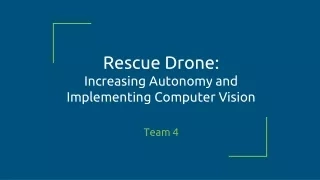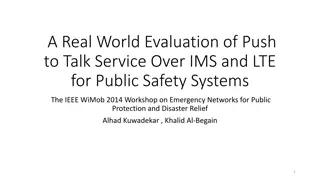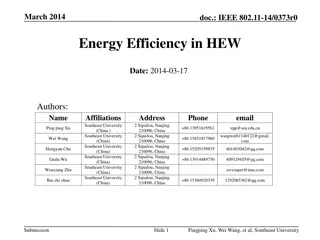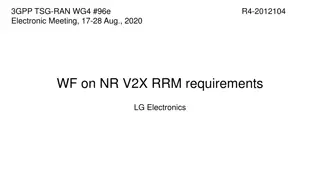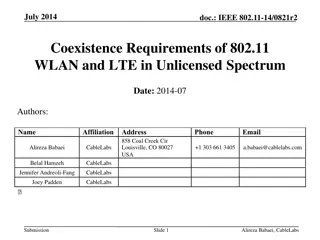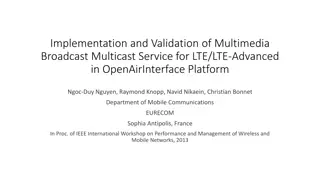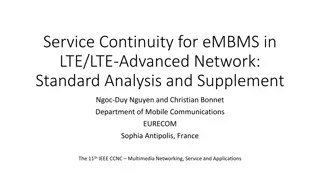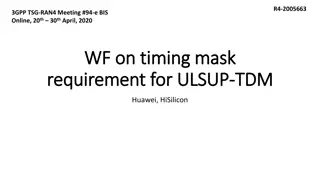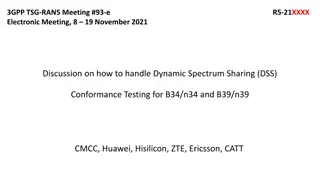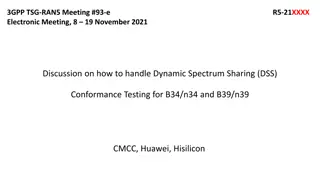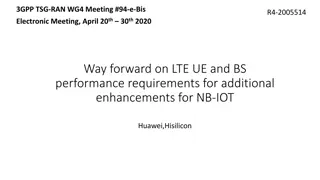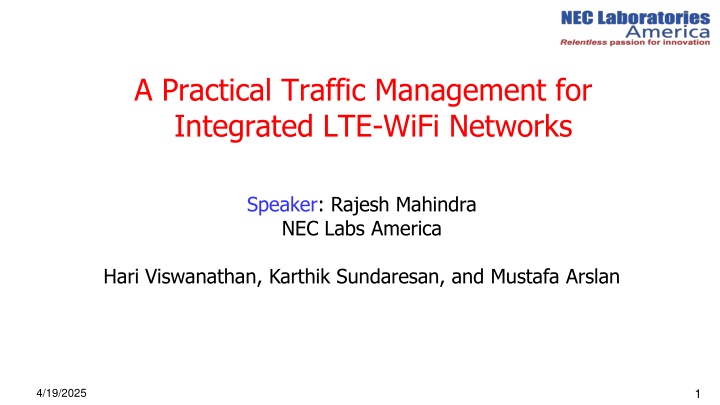
Practical Traffic Management Strategies for LTE-WiFi Networks
Explore practical solutions for managing data traffic in integrated LTE-WiFi networks to optimize Quality of Experience (QoE) and resource utilization. Learn about key trends, challenges in operator-based WiFi deployments, and the resistance to tight integration of LTE and WiFi. Discover the impact on user QoE and strategies to enhance network performance.
Download Presentation

Please find below an Image/Link to download the presentation.
The content on the website is provided AS IS for your information and personal use only. It may not be sold, licensed, or shared on other websites without obtaining consent from the author. If you encounter any issues during the download, it is possible that the publisher has removed the file from their server.
You are allowed to download the files provided on this website for personal or commercial use, subject to the condition that they are used lawfully. All files are the property of their respective owners.
The content on the website is provided AS IS for your information and personal use only. It may not be sold, licensed, or shared on other websites without obtaining consent from the author.
E N D
Presentation Transcript
A Practical Traffic Management for Integrated LTE-WiFi Networks Speaker: Rajesh Mahindra NEC Labs America Hari Viswanathan, Karthik Sundaresan, and Mustafa Arslan 4/19/2025 1
Key Trends Data traffic exploding on cellular networks Rise in video streaming, social networking Revenue per byte is decreasing Mobile operators embracing WiFi as a key technology to enhance LTE experience Cheap to deploy unlicensed Easy (fast) to deploy unplanned Critical to manage flows across APs-Basestations to maximize QoE and resource utilization 4/19/2025 2
Operator-based WiFi deployments Absence of network-wide traffic management Devices always connect to WiFi when available (static policy) Past focus has been authentication methods over WiFi 4/19/2025 3
Today: Devices always connect to WiFi 4/19/2025 4
Operator-based WiFi deployments Absence of network-wide traffic management Devices always connect to WiFi when available (static policy) Past focus has been authentication methods over WiFi Absence of tight data-plane integration 3GPP based deployments have high CAPEX Requires backhauling WiFi traffic through mobile core Increased investment in infrastructure 4/19/2025 5
Today: Resistance to Tight Integration of LTE and WiFi ePDG 3GPP standard WiFi Gateway MME Increased backhaul costs INTERNET Serving-gateway PDN-gateway LTE Core-Network 4/19/2025 6
Operator-based WiFi deployments Absence of network-wide traffic management Devices always connect to WiFi when available (static policy) Past focus has been authentication methods over WiFi Absence of tight data-plane integration 3GPP based deployments have high CAPEX Requires backhauling WiFi traffic through mobile core Increased investment in infrastructure Inability to perform dynamic network selection Result Diminishes the potential effectiveness of WiFi Degrades the user Quality of Experience (QoE) 4/19/2025 7
Opportunity State of the Art: Client-side solutions Qualcomm s CnE, Interdigital SAM Static policies (application level) enforced locally on each client QoE requirements provided by the application on the client Client-side decision making -> inefficient use of network resources Inability for Mobile Operators to perform effective network-wide traffic management! Operator agnostic mobile service (MOTA), in Mobicom 2011 Requires frequent network state information from each base station Incompatible with standards -> difficult to deploy Individual decisions by client -> sub-optimal 4/19/2025 8
Our Idea: A Traffic Management Solution Traffic Manager Maps user flows to appropriate network(LTE/WiFi) Centralized management -> Efficient use of network resources Reduces backhaul costs -> Facilitates dynamic traffic mgmt Operates for each LTE cell -> Scalable Standards agnostic -> Easily Deployable Switching Service Network Interface Assignment WiFi Gateway Serving-gateway PDN-gateway LTE Core-Network MME 4/19/2025 9
Components Network Interface Assignment Algorithm (NIA) Goal: Dynamically maps user traffic flows to appropriate LTE basestation or WiFi AP Interface switching service (ISS) Goal: Switch current user flows from WiFi AP to LTE or vice versa based on decisions from NIA 4/19/2025 10
Component 1: NIA 4/19/2025 11
Problem Formulation Consider an LTE cell and multiple WiFi APs in its coverage area Assign basestation/ AP to each flow Maximize sum of users flows QoE QoE captured using utility Weighted PF provides differential QoE () ) 1 log( P t w U k k + = k max U k Weight Network Pricing Throughput Pricing function supports 2 models Based on data usage Based on price/byte 4/19/2025 12
Throughput Models LTE basestation performs weighted PF WiFi AP performs throughput based fairness Algorithm does not depend on specific scheduler WiFi APs may perform weighted PF 9/9/2014 13
Problem depiction 4Mbps 2Mbps 8Mbps 3Mbps 1Mbps 5Mbps 9/9/2014 14
Problem depiction 2Mbps 3Mbps 5Mbps 4Mbps 2Mbps 6Mbps 9/9/2014 15
Problem depiction 3Mbps 3Mbps 7Mbps 5Mbps 3Mbps 7Mbps 9/9/2014 16
Network Interface Assignment (NIA) Problem is NP-Hard Including the simplest topology of an LTE cell and a WiFi AP NIA is a two-step greedy heuristic Considers each AP-basestation in isolation Fixes assignment for AP that maximized incremental utility Iterate till all hotspots are covered Complexity is O(K2S2), where K = # clients, S = # APs 4/19/2025 17
NIA Example Trigger - arrival/departure of clients or periodic Step 1: In each WiFi hotspot, partition clients into two sets, LTE and WiFi, so that sum of utilities is maximized 4/19/2025 18
NIA Example Step 2: Finalize interface assignment for clients in the WiFi hotspot with the highest incremental utility 4/19/2025 19
NIA Example Iterate Repeat 1&2 with the new initial condition until all hotspots are covered Done! 4/19/2025 20
Component 2: Interface Switching Service 4/19/2025 21
Design Considerations Mid-session network switching capability facilitates dynamic traffic mgmt Leverage HTTP characteristics HTTP traffic (esp video and browsing) dominates (>90% of internet) Session content(s) are downloaded using multiple HTTP requests Video streaming use HTTP-PD (Progressive Download) or DASH (Dynamic Adaptive Streaming over HTTP): A HTTP-GET request/chunk Browsing: A HTTP-GET request/object VIDEO VIDEO Multi-resolution video VIDEO Clients HTTP TCP DASH Server HTTP GET 4/19/2025 22
Interface Switching Service (ISS) Internet Interface to NIA ISS Controller Switch to WiFi HTTP based Video streaming/ Browsing Control Traffic LTE WiFi LTE HTTP-GET HTTP Proxy Mobile Device Switch Interface Application / Browser Control Logic Other types of traffic can leverage existing 3GPP standards for seamless interface switching 23 9/9/2014
Prototype ATOM Squid HTTP Proxy Squid HTTP Proxy NIA Algorithm ISS Control WiFi Gateway OpenEPC LTE Core Dlink WiFi AP NEC LTE Basestation ISS Control Linux Laptop (Client) Shrpx HTTP Proxy HTTP requests Chrome Browser 9/9/2014 24
Experiment 1: Large-scale evaluation Topology: 1 LTE basestation and 3 WiFi APs Result: ATOM performs better than client-side solutions 4/19/2025 25
Experiment 2: Benchmarking the ISS Measured the time taken for flows to switch using ISS: HTTP based video streaming flows Hulu (uses HTTP-DASH) v/s Youtube(uses HTTP-PD) Insight: Switching time improves with DASH streaming DASH flows use smaller chunk sizes to ensure adaptive-ness to changing network conditions 4/19/2025 26
Summary Operators have to look towards exploiting multiple access technologies to increase capacity WiFi offers the cheapest alternate to cellular Our Contributions: a traffic management solution that assigns user flows to LTE basestation/WiFi APs Low complexity, scalable algorithm for flow assignment Network-based solution more effective than client-side solutions HTTP based switching provides dynamic flow assignment at lower costs 4/19/2025 27
4/19/2025 28

